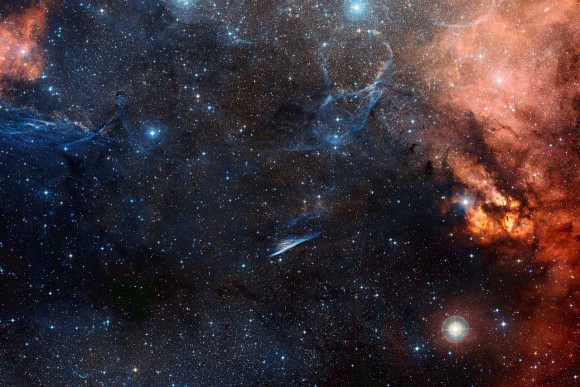Pencil Nebula (NGC 2736) captured by ESO’s La Silla Observatory in Chile. Credit: ESO
This odd-shaped cloud of gas and dust is nicknamed the Pencil Nebula, as the brightest part resembles a pencil. But this pencil looks like it has hair, flying off into the breeze! But that’s no simple breeze: these glowing filaments in NGC 2736 were created by a supernova explosion that took place about 11,000 years ago, and they are moving through the interstellar medium at about 650,000 kilometers (403,000 miles) per hour.
NGC 2736, also called Herschel’s Ray, as it was discovered by British astronomer John Herschel in 1835, is a small part of a supernova remnant in the southern constellation of Vela (The Sails). This detailed new image was taken by the Wide Field Imager on the MPG/ESO 2.2-metre telescope at the La Silla Observatory in Chile. A wider view, below, shows the full view of the Pencil Nebula’s place in the region.
Wide-field view of the sky around the Pencil Nebula. Credit: ESO
The Vela supernova remnant is an expanding shell of gas that originated from the supernova explosion. Initially the shock wave was moving at millions of kilometers per hour, but as it expanded through space it plowed through the gas between the stars, which has slowed it considerably and created strangely shaped folds of nebulosity. The Pencil Nebula is the brightest part of this huge shell.
This new image shows large, wispy filamentary structures, smaller bright knots of gas and patches of diffuse gas. The nebula’s luminous appearance comes from dense gas regions that have been struck by the supernova shock wave. As the shock wave travels through space, it rams into the interstellar material. At first, the gas was heated to millions of degrees, but it then subsequently cooled down and is still giving off the faint glow that was captured in the new image.
By looking at the different colors of the nebula, astronomers have been able to map the temperature of the gas. Some regions are still so hot that the emission is dominated by ionized oxygen atoms, which glow blue in the picture. Other cooler regions are seen glowing red, due to emission from hydrogen.
The Pencil Nebula measures about 0.75 light-years across. ESO says that remarkably, even at its distance of approximately 800 light-years from Earth, at the speed it is traveling means that it will noticeably change its position relative to the background stars within a human lifetime.
The video below zooms in to the Pencil Nebula:
Source: ESO


